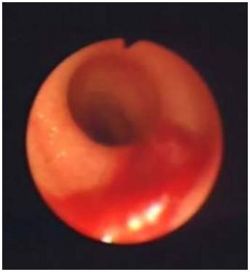Oesophagitis
| This article has been peer reviewed but is awaiting expert review. If you would like to help with this, please see more information about expert reviewing. |
Description
Oesophagitis refers to inflammation of the oesophagus. This usually involves the mucosa but can involve the deeper layers of the submucosa and muscularis and it may follow an acute or chronic course. The oesophagus is usually protected from physical or chemical damage by mucus (produced by simple tubuloacinar glands along its whole length in dogs and in the rostral portion in cats), by peristaltic waves and by the upper and lower oesophageal sphincters which together prevent ingesta or regurgitated material from remaining in contact with the oesophageal wall. Oesophagitis is a serious condition and, if not treated, it may progress to ulceration, rupture, stricture formation or derangement of normal motility (megaoesophagus). The most common causes are:
- Physical Injury
- Ingestion of foreign bodies which lodge in the oesophagus.
- Passage of nasogastric or pharyngostomy feeding tubes or of large endoscopes.
- Chemical Injury
- Gastro-oesophageal reflux, which may occur with general anaesthesia or hiatal hernias.
- Chronic vomiting
- Ingestion of caustic or irritant substances, including doxycycline in cats.
Signalment
Any age group can be affected and there is usually a history suggestive of a particular cause, such as a recent general anaesthetic or administration of doxycycline to a cat.
Diagnosis
Clinical Signs
Signs include:
- Regurgitation and hypersalivation/ptyalism are the most common signs. Regurgitation can be recognised if the animal shows no abdominal effort (as would occur with vomiting) and if the material produced still resembles the food that was eaten with little apparent digestion. The material produced is often covered with white foam but bile should never be present.
- Animals may appear to have difficulty in swallowing and often appear to make multiple swallowing efforts and to extend their necks during swallowing.
- Animals may show signs of pain during swallowing (odynophagia) and may therefore become anorexic.
- Like any animals which regurgitate repeatedly, those with oesophagitis may develop aspiration pneumonia and show signs of pyrexia, coughing, tachypnoea and dyspnoea.
Laboratory Tests
The results of diagnostic tests are usually unremarkable but, as with any inflammatory process, there may be an overall leucocytosis caused by neutrophilia in the acute stage.
Diagnostic Imaging
Plain radiographs of the chest usually show little inidcation of disease but signs of aspiration pneumonia (an alveolar pattern) may be seen in cranio-ventral lung lobes. Barium contrast studies could be performed and these may show an irregular mucosal surface and narrowing or dilation of the oesophagus due to stricture formation or megaoesophagus, respectively. Barium should not be administered if an oesophageal rupture is suspected as it may escape into the mediastinum and initiate a foreign body reaction.
Endoscopy is the gold standard technique for diagnosis of oeosphagitis but it requires a general anaesthetic (which may be the cause of the problem) and, if a large endoscope is used, there is the potential to cause further traumatic damage. Since medical management of oesophagitis is generally inexpensive, it is rarely advisable to perform this technique in an animal suspected of having active inflammation. If it is performed, the oesophagus may be seen to have an oedematous mucosa that is hyperaemic, ulcerated and actively bleeding, whilst less severe cases may require several mucosal biopsies to diagnose the condition definitively.
Treatment
Since oesophagitis can lead to serious sequelae, even mild inflammation should be treated aggressively. Any animal which suffers gastro-oesophageal reflux under general anaesthesia should receive metaphylactic treatment as described below. Components of medical management include:
- Withdrawal of oral food for 2-3 days as standard but, if the inflammation is severe or rupture has occurred, a gastrostomy tube may be required.
- Oral sucralfate suspension is thought to bind to the base of any ulcers, to stimulate epithelial repair and to neutralise any refluxed gastric juices.
- Gastric acid secretory inhibitors (e.g. ranitidine, omeprazole) can be useful in cases of gastro-oesophageal reflux.
- Metaclopramide, a promotility drug that increases the tone of the lower oesophageal sphincter, may also be used to manage gastro-oesophageal reflux but not if oesophageal motility is thought to be impaired (i.e., if megaoesophagus is present).
- Broad spectrum intra-venous bactericidal antibiotics may be required in animals with severe oesophagitis or aspiration pneumonia. Coupage and nebulisation may be useful adjunctive treatments for aspiration pneumonia and it may be necessary to provide oxygen to dyspnoeic animals.
- Analgesia should be provided to encourage animals to eat after 2-3 days.
Prognosis
Mild oesophagitis has a good prognosis if treated aggressively but animals which develop ulceration, strictures or aspiration pneumonia have a much more guarded prognosis.
Literature Search
Use these links to find recent scientific publications via CAB Abstracts (log in required unless accessing from a subscribing organisation).
Oesophagitis publications
References
Hall, E.J, Simpson, J.W. and Williams, D.A. (2005) BSAVA Manual of Canine and Feline Gastroenterology (2nd Edition) BSAVA
Ettinger, S.J, Feldman, E.C. (2005) Textbook of Veterinary Internal Medicine (6th edition, volume 2) Elsevier Saunders
Merck & Co (2008) The Merck Veterinary Manual

